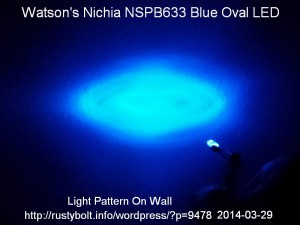 I received my package of LED’s in the mail today from goldmine-elec.com. Quantsuff emailed a link to their sale on the Nichia NSPB633 blue oval LED (it might say NPSB, but that’s a typo). They are on sale for 100 for $10. I ordered some and I have been playing around, err, experimenting with them for the last few hours. I put one in an old Joule Thief and took some pictures of the light pattern it left on the wall. If you ask me it looks like a flying saucer or a UFO! Really. The oval shape of the lens makes the light pattern oval shaped, however the lens shape is 90 degrees rotated from the light pattern shape. Also, the pattern is wider than a typical LED, probably about 20 to 40 degrees depending on which dimension of the oval pattern is measured.
I received my package of LED’s in the mail today from goldmine-elec.com. Quantsuff emailed a link to their sale on the Nichia NSPB633 blue oval LED (it might say NPSB, but that’s a typo). They are on sale for 100 for $10. I ordered some and I have been playing around, err, experimenting with them for the last few hours. I put one in an old Joule Thief and took some pictures of the light pattern it left on the wall. If you ask me it looks like a flying saucer or a UFO! Really. The oval shape of the lens makes the light pattern oval shaped, however the lens shape is 90 degrees rotated from the light pattern shape. Also, the pattern is wider than a typical LED, probably about 20 to 40 degrees depending on which dimension of the oval pattern is measured.
I looked up the NSPB633 on the Nichia website but it didn’t show it. So I used Google to search for that number and it gave me a .PDF from Nichia of discontinued LEDs, where I found it. Apparently that’s the reason why they are going surplus and the price is low. These are brand new LED’s right out of the fan folded tape, they’re not rejects or “pre-owned” as the used car dealer says. The epoxy lens is not water clear, it’s pale blue. They’re about the same size as a 5 millimeter LED. There doesn’t seem to be any lip at the bottom and I couldn’t find a flat spot. So you have to go by the lead length, or the geometry that you see inside.
Since I couldn’t find any data sheet, I have to assume that the specifications are basically the same as a standard blue 5 millimeter LED. I guess that there is not too much difference between the two, other than the case and the light pattern. I guess I can’t complain for the price!
I think the best uses for these blue LEDs is for Christmas lights and other displays where you want blue light to be spread out over a wider pattern. They’re not extremely bright but that’s because the pattern is wide.
I’ve been using LEDs as a light sensor to turn off my Blue Blinky flashers during the daytime. Typically I use LEDs that are as cheap as I can get. Cheap red ones work fine and so do the dim, ugly yellow LEDs. I’m going to have to measure one of these blue oval LEDs to find out if they have any advantages for this application, because they’re inexpensive.











